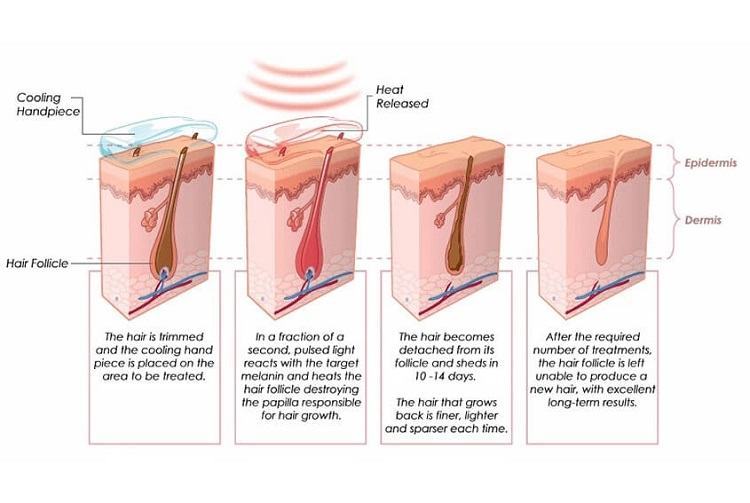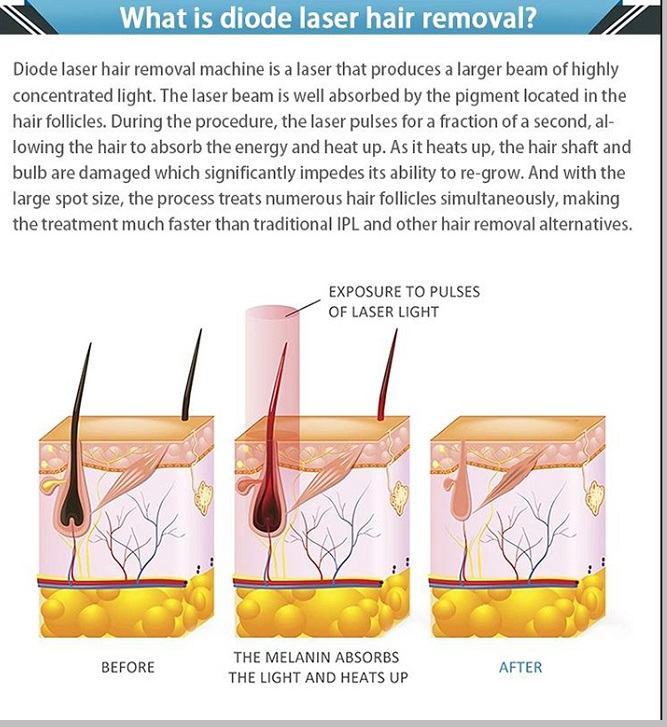What do dermatologists say about laser hair removal? All you need to know about laser hair removal. Laser hair removal is one of the most popular permanent hair removal methods because this is a fast, safe and reliable way to remove unwanted hair. Using a laser to stop the hair follicles from growing new hair, this method is more appreciated than other methods such as plucking, shaving, waxing, electrolysis or chemicals, etc. However, before deciding to choose laser hair removal, you should learn carefully about the side effects and risks of this method.
Contents [show]
What is diode laser hair removal?
Factors such as age, sex, body weight, hormones, genetics, metabolic status, race, location of hair growth, drugs, weather, etc. all affect the development process. hair growth. Hair grows in 3 stages: Anagen (Active growth phase) – Catagen (Transition phase) – Telogen (Resting phase). At one time, hair in different locations on the body would be at different stages. As a result, all body hair does not fall out at once.
What is diode laser hair removal?
Diode laser hair removal is a technique that emits a strong beam of light and is absorbed by the pigments in the hair follicle. The more pigmented (dark) the hair is, the more effective it will be. The laser pulses fired will evaporate the pigment, reducing damage to the surrounding skin. The hair follicles will absorb the laser energy, impairing the ability to grow new hairs.
See also BEST HEAT PROTECTANTS FOR NATURAL HAIR
While laser hair removal usually does not provide permanent results, many studies show that areas where laser hair has been removed often grow back more slowly than other methods. In particular, diode laser hair removal is very effective in stopping hair growth at the active growth phase.
Indications for laser hair removal
Indicationslaser hair removal
Body area hair removal: Lasers for hair removal can be used on almost any part of the body. Many types of laser can effectively treat large areas of skin such as back, chest, private area, face (especially mustache and chin), shoulders, neck, arms, legs,…;
Subjects of hair removal: Because the energy is absorbed by the dark pigmented areas, laser hair removal works best for light-skinned and black-haired people. For those with darker skin, more treatments are needed. People with light hair do not respond well to lasers because there is little or no dark pigment in the hair follicles;
Treatment time: The number of treatments depends on the skin color, coat color, thickness, hardness of the hair and the area to be treated. On average, after 3-5 treatments, each 4-6 weeks apart, the hair will grow about 50-80% less.

Laser hair removal procedure
Preparation
- Avoid sunlight for 4 weeks prior to treatment. Users should protect their skin by using a broad-spectrum sunscreen with an SPF of 50 or higher;
- Avoid other hair removal treatments for 4 weeks prior to treatment. Methods such as: Plucking, waxing, electrolysis, … can affect hair follicles;
- Avoid taking blood thinners such as anti-inflammatory drugs, aspirin or products that can cause photosensitivity before treatment;
- It is recommended to cut, shave the day before laser treatment to remove the hair on the skin surface;
- Do not take isotretinoin within 6 months prior to laser hair removal treatment;
- Inform your doctor about a history of herpes virus infection in the area that needs hair removal as the patient may need prophylactic treatment.
See also Bob Hairstyles Trends
Implementation process
Patients are cleaned the hair removal area, some patients are prescribed numbing medicine. If hair removal is on a small area in a patient with sensitive skin, it is necessary to numb the treatment area for about 1 hour for the anesthetic to take effect;
Diode laser hair removal is performed in a private room fitted with the device. The doctor and the patient need to wear eye protection during the procedure. During the procedure, the skin is kept taut and laser beamed. When irradiating the laser, the patient will feel warm skin, there is a slight stinging sensation;
Hair removal time depends on the size of the treatment area. Mustache removal usually only takes a few minutes, but hair removal on the back or legs can take more than an hour.
Results
After laser hair removal, in most patients, hair does not grow back for several months or years. When it grows back, the hair is also usually much less dense than before, thinner and lighter in color. To make sure hair doesn’t grow back, you may need maintenance treatment.

Some notes after laser hair removal
After diode laser hair removal treatment, patients need to follow all instructions of the doctor to reduce the risk of side effects. Some notes include:
- After treatment, the skin is often red and swollen like a mild sunburn. The patient can relieve discomfort by applying ice packs;
- Avoid exposing the treated area to direct sunlight;
- Do not use artificial tanning machines, ultraviolet lamps, indoor sunbathing equipment,…;
- Do not use tan dye;
- Protect your skin by using sunscreen. Sunscreen should be applied before going out with SPF 50+ and waterproof.
See also Top best hair conditioner for oily hair
Side effects of laser hair removal
Although effective and safe, laser hair removal can also cause some side effects. Side effects when laser hair removal will vary depending on skin type, hair color, treatment plan, patient coordination before and after treatment, …
Some common side effects
Skin irritation: The patient’s skin may be uncomfortable, swollen and red for a short time after treatment. These symptoms usually resolve within a few hours;
Pigmentation changes: Laser hair removal can increase or decrease pigmentation in the treatment area. This is usually a temporary reaction. These changes tend to fade, the skin will return to normal;
Rare side effects of laser hair removal
Rare side effects include blistering, crusting on the skin, changes in skin structure or skin infection, scarring. In addition, the patient may have gray hair, excessive hair growth around the treatment area. Therefore, it should be noted, do not laser hair removal on the eyelids, eyebrows or surrounding skin to avoid the risk of serious eye injury.
Laser hair removal is a safe and effective procedure, and if done correctly, some people may have mild side effects and return to normal really soon. However, if you notice any unusual symptoms, the patient should go to the doctor for early treatment to avoid dangerous complications.





































